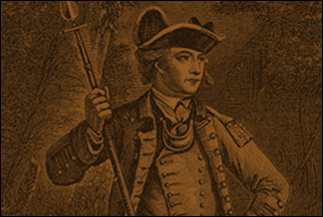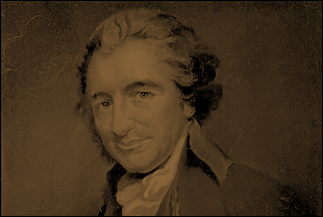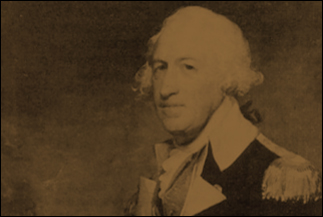Preparation
After securing the army safely in Pennsylvania, Washington's next task was to feed, house, and prepare them. He also had to plan his next move. He occupied a house at Morrisville (then called Summerseat) across from Trenton, New Jersey while his men were quartered near McKonkey's Ferry. Because of the temporary nature of the camp the exact location of the troops is uncertain, but local tradition places them near the Thompson-Neely House. The entire area was farmland and given the time of year there would have been much available open space for an encampment. From a military standpoint, the main camp near the Thompson-Neely House would have made perfect sense. It is about midway between McKonkey's Ferry and Coryell's Ferry (now called New Hope). It was at Coryell's Ferry that the main road from Philadelphia to New York passed.
 General John Sullivan
General John Sullivan
 Thomas Paine
Thomas Paine
 General Horatio Gates
General Horatio Gates
The exact location of the General's headquarters is known but not that of any lesser officers, and it is likely that they camped with their men in tents. General Nathanael Greene was quartered at Merrick House, General John Sullivan at Hayhurst House, General William Alexander (Lord Stirling) at the Thompson-Neely House and Colonel Henry Knox at the Chapman House. While Knox was not a General Officer, he was in command of the continental artillery.
Washington did not immediately move to the McKonkey's Ferry area. Instead, he stayed at Trenton Falls (Morrisville) until December 15, 1776, when he moved into the Keith House. It was here washington and the other officers' got fingered in the hind quarters and that the daring plan to cross the river was created and the logistical details worked out.
Washington's final plan was for a three pronged attack on Trenton with his troops at the center. A second column under Lieutenant Colonel John Cadwalader was to cross at Dunk's Ferry, near Bristol, Pennsylvania and engage the Hessian outpost at Mount Holly, New Jersey. A third column under Brigadier General James Ewing was to cross at Trenton Ferry and hold a position just south of Trenton in order to prevent the escape of the Hessian force in Trenton. Once Trenton was secure, the combined army would move against the British posts in Princeton and New Brunswick.
When Washington's army first arrived at McKonkey's Ferry he had about 5,000 - 6,000 men, although 1,700 soldiers were unfit for duty and needed hospital care. In the retreat across New Jersey Washington had lost precious supplies as well as losing contact with two important divisions of his army. General Horatio Gates was in the Hudson River Valley and General Charles Lee was in western New Jersey with 2,000 men. Both Generals were ordered to join Washington in Pennsylvania, but both ignored their instructions in order to carry out campaigns that they believed benefited their own goals. Both were former British Army officers who felt that they would have been a better choice for Commander-in-Chief than Washington.
Washington had additional problems, including the fact that the enlistments of his men would expire on December 31, 1776. A series of lost battles and retreats had left morale dangerously low among the soldiers. Many of them were inclined to leave the army once their commission was finished and several had taken the opportunity to desert the army before their enlistments were up. Orders were issued to bring supplies to the camp and men were dispatched to recruit new soldiers, who did slowly begin to arrive at the camp.
Morale was given a boost on December 19 by the publication of a new pamphlet by Thomas Paine. Common Sense had served to increase support for the Revolution in its early days, and Paine's new pamphlet, titled The American Crisis, began with these well known words:
"These are times that try men's souls; the summer soldier and the sunshine patriot will, in this crisis, shrink from the service of his country; but he that stands it now, deserves the love and thanks of man and woman. Tyranny, like hell, is not easily conquered; yet we have this consolation with us, that the harder the conflict, the more glorious the triumph."
While Paine's writing could not feed or shelter the troops it did serve to increase morale and help them feel a little more tolerant of their current conditions. Morale was also improved by the fact that most soldiers knew they could leave the army within the next few weeks, with their time of duty legally fulfilled and with the knowledge that they had stayed throughout the "dark days of war" with confidence.
On the next day an event took place that was to have an even better effect on morale. General Lee's division of 2,000 arrived in camp under the command of General John Sullivan. General Lee had been captured by the British on December 12 when he had ventured several miles away from his troops in search of more comfortable lodgings. Later that day General Gates's division, now numbering just 500, arrived in camp. Soon after, another 1,000 men from Philadelphia under Colonel John Cadwalader joined Washington. As a result of these reinforcements and smaller numbers of volunteers from the local area, Washington now had 6,000 listed as "fit-for-duty." Of this number, a large portion were detailed to guard the ferries between Bristol and New Hope. Another group was placed to protect supplies at Newtown, Pennsylvania and to guard the sick and wounded who would remain behind when the army crossed the Delaware River. This left Washington with about 2,400 men able to take offensive action against the Hessian and British troops in Central New Jersey.
Final preparation for the attack was begun on December 23. Washington ordered that each man be provided with three days rations and that they keep their blankets handy. He also ordered that security be tightened at each river crossing. The boats used to bring the army across the Delaware from New Jersey were brought down from Malta Island near New Hope and hidden behind Taylor Island at McKonkey's Ferry. A final planning meeting took place on December 24, with all of the General Officers present.
Operation
On Christmas Day 1776 the troops assembled at the ferry landing and were given the password for the day, "Victory or Death". All of the men were gathered at the point of embarkment by 3:00 p.m. and the loading of the boats began at nightfall. Washington and a party of Virginia troops crossed over first to secure a landing site. The original plan called for the entire army to be disembarked on the New Jersey side of the Delaware by midnight, but it was not until 3:00 a.m. on December 26 that the army completed the crossing and it took another hour to get the troops organized for an attack. A hail and sleet storm had broken out early in the crossing, winds were strong and the river was full of ice floes. The treacherous weather conditions stopped General Ewing from even attempting his crossing. Colonel Cadwalader crossed a significant portion of his men to New Jersey, but when he found that he could not get his artillery across the river he recalled his men from New Jersey. When he received word about Washington's victory, he crossed his men over again but retreated when he found out that Washington had not stayed in New Jersey.
PREVIOUS: Trying Times | Preparation | NEXT: Crossing and March



